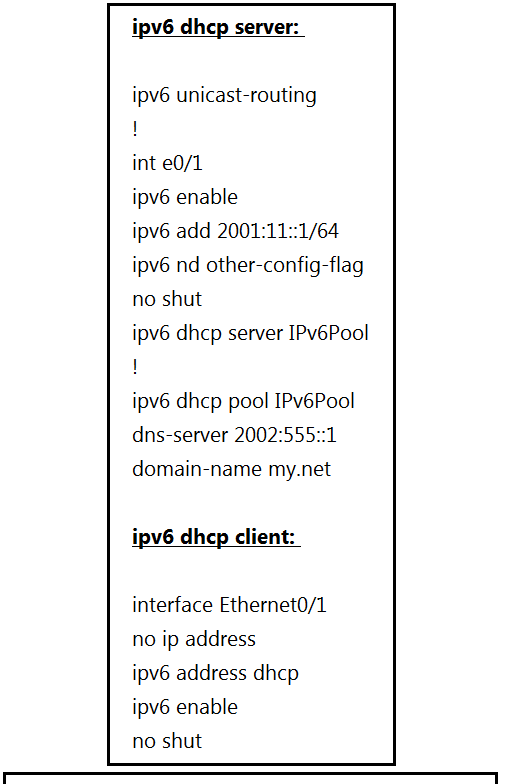
Refer to the exhibit. A network administrator is troubleshooting IPv6 address assignment for a DHCP client that is not getting an IPv6 address from the server.
Which configuration retrieves the client IPv6 address from the DHCP server?

Refer to the exhibit. A network administrator is troubleshooting IPv6 address assignment for a DHCP client that is not getting an IPv6 address from the server.
Which configuration retrieves the client IPv6 address from the DHCP server?
To retrieve a client IPv6 address from a DHCP server, the configuration needs to appropriately enable DHCP on the client side. In the given scenario, the configuration shown for the client includes the command 'ipv6 address dhcp', which is intended to obtain an IPv6 address via stateful DHCP. However, this setting expects the DHCP server to assign an address. The command 'ipv6 address autoconfig' configures the client to use Stateless Address Autoconfiguration (SLAAC), allowing it to generate its own address when a router advertisement is received. Therefore, the most accurate configuration is 'ipv6 address autoconfig' to ensure the client can generate an address automatically based on the network prefix advertised by the server.
The closest solution seems to be "ipv6 address autoconfig", however this configuration is not going to achieve ipv6 address assignment by the DHCPv6 server. https://www.routerfreak.com/the-idiosyncrasies-of-ipv6-on-cisco-devices/ https://networklessons.com/ipv6/cisco-dhcpv6-server-configuration
Based on the output, the ipv6 dhcp server is configured to do DHCPv6 Stateless Configuration. The command "ipv6 nd other-config-flag" on the server tells the client to use DHCPv6 to receive extra information (domain name and DNS server) after they used autoconfiguration. However, the client is configured to use "ipv6 address dhcp" to obtain an address through stateful DHCPv6, that process is not working. Stateful DHCPv6 (obtaining ipv6 address) is not possible since the ipv6 address prefix is not set under the dhcpv6 pool.
After all, the client needs "ipv6 address autoconfig" to obtain an ipv6 address. -> Besides the link-local address, a global unicast address is also going to be been added (if there are other ipv6 devices on the segment). "ipv6 enable" -> IPv6 is enabled on the interface, so the interface has been automatically configured with a link-local IPv6 address. This command is not needed if we use "ipv6 address autoconfig" .
This question is unclear. "Which configuration retrieves the client IPv6 address from the DHCP server?" This automatically raises questions as to which part we are required to configure. From the client output we only have port level configuration. So from all the valid options the "ipv6 address autoconfig" is the one that match to what we have. However with this command you configure SLAAC and not DHCP.
When the command "ipv6 nd managed-config-flag" is NOT configured on the server for the interface facing the client. Client will need to obtain its ipv6 address via slaac. Client interface facing the server -> ipv6 address autoconfig A makes the best option
option A: https://www.cisco.com/c/en/us/td/docs/ios-xml/ios/ipaddr_dhcp/configuration/xe-16/dhcp-xe-16-book/ip6-dhcp-stateless-auto.html
option A is correct
A is correct, the first step is using the ipv6 address autoconfig to create the link-local address for the interface, then the ip address will be assign to the interface using dhcp server, and the command is "ipv6 address dhcp"
The config is invalid, there is no such "ipv6 address dhcp" command for the client.
Seems you might be wrong on this one: https://www.cisco.com/c/en/us/td/docs/ios-xml/ios/ipv6/command/ipv6-cr-book/ipv6-i1.html#wp2212047392